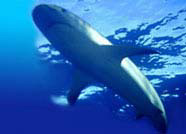


Digestive System

 |
 |
 |
|||
| Home | Evolution
| Classification
| Glossary | Biology
| Behavior | Shark
Repellent | Shark
Conservation | Do's &
Don'ts | Did You Know?
Digestive System |
 |
||||
|
A shark's digestive system is as great as the shark
itself. In order to survive, a shark must eat 0.6-3% of its body weight,
each day. A shark has an expandable stomach to support this eating. Most
sharks have selective stomachs, as many sharks eat whatever comes in their
way. So till the selective stomachs are digesting whatever is digestible,
sharks can go on feeding themselves without any problem. Later, they spit
out the things, which are left undigested.
Shark's stomach can receive large quantities in one sitting. This is important for any species that scours the open ocean, such as the oceanic whitetip shark whose food is widely scattered and whose next meal is far from certain. Some species, such as the great white and mako, ensure food is dealt with quickly by having a body that is warmer than the surrounding seawater and a warm stomach. A Mako, therefore, is able to digest a meal within one or two days, whereas other hunters, such as the blue shark, take an average of three days to digest a similar quantity of food. All sharks have a relatively short gut, which is equipped internally with a special valve structure. Each species has a valve of a different design, and some closely related species, such as deep-sea lantern sharks are difficult to tell apart except for the number of twists and turns in their (spiral-shaped) valves. The valve arrangement slows down the passage of food, allowing digestion to take place more effectively and nutrients to be absorbed more efficiently. But there is a downside, too, to this arrangement. |
|
|||||||||||
| Sitemap | Reach To Us | Jimtrade - Business Directory of India | ||||||||||||